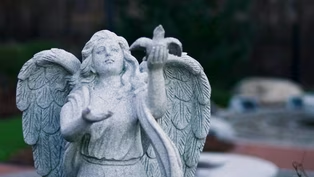
Providence Art Club
Clip: Season 4 Episode 8 | 9m 1sVideo has Closed Captions
Black artist Edward Bannister’s legacy at the Providence Art Club lives on 150 years later
Black artist Edward Mitchell Bannister led a creative group of men and women to found the Providence Art Club nearly 150 years ago. Today, housed in four historic buildings on Thomas Street, it still thrives as a place for artists to create, congregate and circulate their works for patrons to purchase. Now, the Providence Art Club is honoring the legacy of Edward Bannister in the Creative Capital.
Problems playing video? | Closed Captioning Feedback
Problems playing video? | Closed Captioning Feedback
Rhode Island PBS Weekly is a local public television program presented by Ocean State Media

Providence Art Club
Clip: Season 4 Episode 8 | 9m 1sVideo has Closed Captions
Black artist Edward Mitchell Bannister led a creative group of men and women to found the Providence Art Club nearly 150 years ago. Today, housed in four historic buildings on Thomas Street, it still thrives as a place for artists to create, congregate and circulate their works for patrons to purchase. Now, the Providence Art Club is honoring the legacy of Edward Bannister in the Creative Capital.
Problems playing video? | Closed Captioning Feedback
How to Watch Rhode Island PBS Weekly
Rhode Island PBS Weekly is available to stream on pbs.org and the free PBS App, available on iPhone, Apple TV, Android TV, Android smartphones, Amazon Fire TV, Amazon Fire Tablet, Roku, Samsung Smart TV, and Vizio.
Providing Support for PBS.org
Learn Moreabout PBS online sponsorship- Up next, Providence is called the Creative Capital, and no wonder, it boasts the Rhode Island School of Design and Museum, Trinity Rep, dozens of galleries, and, for nearly 150 years, the Providence Art Club.
It's one of the oldest in the nation.
Tonight, a look inside at the talent and tolerance of its founding members and its influence on the art scene today.
- [Pamela] Behind the big green door of the Providence Art Club lies a canvas of contemporary galleries, painting classes, Old World dining rooms, and a collection of works by its members stretching back decades.
Dan Mechnig has belonged for almost 40 years.
- [Dan] It seems like you're in a time machine and there's some ambiance that comes from even the foyer, and you'll look up the stairs and you'll see time going by.
- [Pamela] In 1880, when women didn't even have the vote and Black artists were practically non-existent, a group from the east side of Providence made a bold stroke.
- The Art Club here was founded by 16 people and six were women.
And they were not all artists.
There were patrons involved.
Founded for art culture.
That's the mission.
But they also wanted the comradery of people that felt the same way about life and what they did, you know.
And they made a great time of it.
- [Pamela] Anne Mechnig says many of those great times happened here in the tiny cabaret room.
There are stories of early members smoking long clay pipes, which continue to line the walls today along with vintage wine bottles that hang from the ceiling.
Overseeing all the festivities, a devil painted in the rafters.
But as unconventional as some of the antics may seem, the founders were serious about their art and well-respected in the community.
One of their leading members, Black artist Edward Mitchell Bannister, oil painter, abolitionist, philanthropist.
Of all the striking silhouettes of artists and patrons lining the walls of the club, Bannister's has a distinction, the number one indicating he was the prime mover of the Providence Art Club.
In a day when we're actively discussing representation in the arts community, the Providence Art Club, it seems, was ahead of its time.
- Oh, without question.
- [Pamela] Nancy Gaucher-Thomas is both artist and former president of the Providence Art Club.
Why were they willing to rally around Edward Bannister, a Black artist?
- Well, I think that they saw that he was an artist of note.
They recognized, you know, who he was.
Artists don't see Black and white.
It was his commitment to his work and everything that he did to help create the New England cultural community.
- [Pamela] The rural New England community and Narragansett Bay Shoreline are prominent themes in Bannister's landscapes.
There are some on display at the Providence Art Club.
Many more hang at the Smithsonian.
What was so impressive about his painting?
- You could see and you could feel the heart and soul that he put into his work.
His work just exudes an atmosphere that is hard to attain.
And you have to remember, too, he did not go to Europe to study art and so a lot of this was experimentation.
His landscape scenes were very bucolic, very serene, very somber tones in his palette.
His work wasn't good because he was an African American.
His work was great because he was a dedicated painter.
And that's all he wanted to do.
- And Gaucher-Thomas says Bannister's fierce dedication was fired up by an article he read in the New York Herald in 1867.
- Quote, "The negro seems to have an appreciation for art while being manifestly unable to produce it."
End quote.
Ironically, less than a decade later, in 1876, Bannister was a first African American to receive a first-prize medal award.
- [Pamela] It happened at the Philadelphia Centennial Exposition and it caused a sensation when the judges announced the winner from hundreds of artists entered in competition.
- He went up to get his award and they were a little taken aback and said, "This can't, you know, this can't be right.
He's a Black man."
They wanted to rescind it.
They wanted to take it away.
And there were white artists that came in and said, "No, he's getting his award."
And he did.
- [Pamela] Bannister's award certificate is one of the Art Club's most prized possessions.
Another artist who made her mark on the Providence Art Club was sculptor Florence Brevoort Kane.
- [Dan] She was born in the late 1880s to an extraordinarily wealthy family in New York City.
- [Pamela] Her family summered in Narraganset.
Kane was disabled after a childhood illness left her deaf and unable to talk, yet her talent spoke volumes.
She was sculpting in France when Hitler rose to power and started stealing artwork.
- Her father realized what was happening and he wanted her home.
But she was working on all these pieces, so they buried the work that she was working on on the property in cons.
And when the war was over, they sent an agent back and they uncovered all of that work and it was sent back to the United States.
Well, she became a member in the late 1940s.
She was readily accepted.
- [Pamela] Kane's sculptures are prominently displayed in the Angells Lane Room at the Art Club.
There are horses, a likeness of her baby brother, and other works.
Her bust of President Eisenhower resides in the White House.
And when Kane died, she left a substantial bequest starting the endowment for the Art Club.
Another legacy was left by the artist who crafted these dragon andirons.
- [Dan] It looks like they're spiting fire at you.
They're really, really cool.
And they were handmade by Sydney Burleigh.
- [Pamela] Burleigh was a founding member of the Art Club.
The landmark Fleur de Lys Building was Burleigh's studio.
It is one of the four historic buildings that house the Providence Art Club.
Inside the Fleur de Lys, Burleigh continued his dramatic dragon theme.
Upon his death, Burleigh willed the property to the Art Club with the stipulation it must always remain an artist studio.
Currently, Anthony Tomaselli is the artist in residence.
Popular Rhode Island painter Maxwell Mays also worked in this studio on story-like depictions of New England scenes.
The Providence Art Club celebrates its members and patrons present and past.
A current project is honoring the life of Edward Bannister.
This is a miniature of what will soon be a fixture in Market Square near the Rhode Island School of Design Auditorium.
- And the wonderful thing about this sculpture is that it's not a monument.
He's not standing on a pedestal looking down at people.
He's actually sitting on a bench kind of waiting for people to sit next to him.
He has a sketch pad in hand, and on the sketch pad is a sketch of his wife Christiana Carteaux.
- [Pamela] The sculpture is being cast life size in bronze at a Massachusetts foundry.
It's the finishing touch for a man whose talent and tenacity broke down barriers, leaving a legacy that's not lost on all those drawn to visit the Art Club.
(gentle music) (soft music) (soft music fades out)
Video has Closed Captions
Clip: S4 Ep8 | 8m 55s | Loved ones of victims find solace at Station Fire Memorial. (8m 55s)
Video has Closed Captions
Clip: S4 Ep8 | 9m 38s | The new sheriff in Bristol County wants to run what he calls a more modern jail system. (9m 38s)
Providing Support for PBS.org
Learn Moreabout PBS online sponsorship
- News and Public Affairs

Top journalists deliver compelling original analysis of the hour's headlines.

- News and Public Affairs

FRONTLINE is investigative journalism that questions, explains and changes our world.












Support for PBS provided by:
Rhode Island PBS Weekly is a local public television program presented by Ocean State Media

